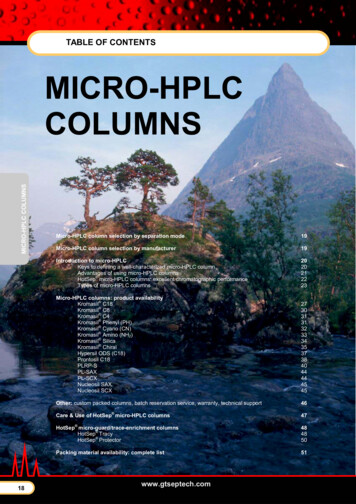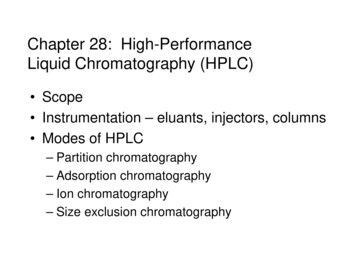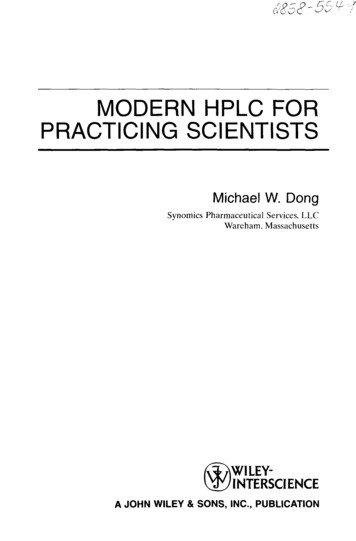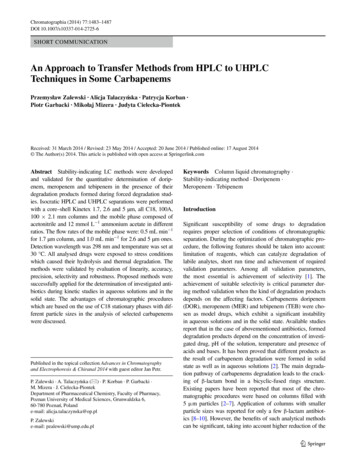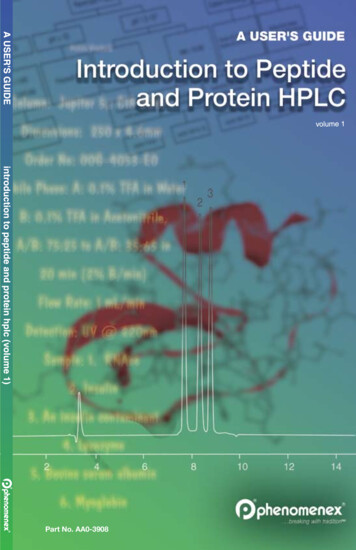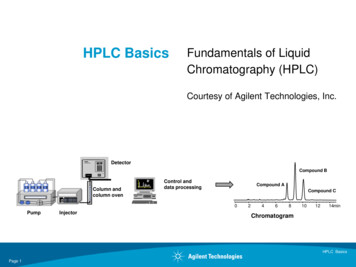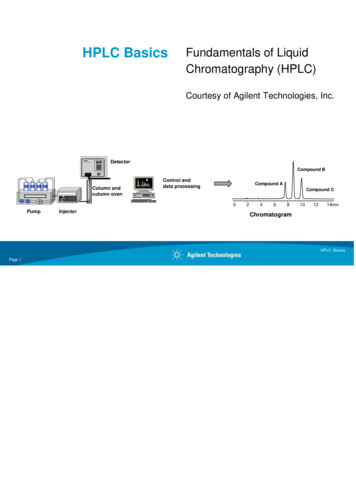
Transcription
HPLC BasicsFundamentals of LiquidChromatography (HPLC)Courtesy of Agilent Technologies, Inc.DetectorCompound BColumn andcolumn ovenControl anddata processingCompound ACompound C0PumpInjector2468101214minChromatogramHPLC BasicsPage 1
Fundamentals of High Performance LiquidChromatography (HPLC)This course will enable you to:Explain the general principles of HPLC analysesKnow the major application areas of HPLCIdentify the major components of an HPLC systemand explain their principles of operationHPLC BasicsPage 2
Chromatographic Separation TechniquesWhich separation technique for which compound?HPLC BasicsPage 3
First, What is Liquid Chromatography?Liquid chromatography is a separation technique that involves:the placement (injection) of a small volume of liquid sampleinto a tube packed with porous particles (stationary phase)where individual components of the sample are transported alongthe packed tube (column) by a liquid moved by gravity.The components of the sample are separated from one another by the columnpacking that involves various chemical and/or physical interactions between theirmolecules and the packing particles.The separated components are collected at the exit of this column and identifiedby an external measurement technique, such as a spectrophotometer thatmeasures the intensity of the color, or by another device that can measure theiramount.Note: The modern form of liquid chromatography is now referred toNote: Look for the comparison with HPLC on page 7HPLC BasicsPage 4
Principles of Liquid stationaryphaseCollectcomponentsTimeHPLC BasicsPage 5
Then, What is HPLC?HPLC is an abbreviation forHigh Performance Liquid Chromatography(It has also been referred to as High Pressure LC)HPLC has been around for about 35 years and is the largestseparations technique usedThe history of HPLC:Liquid ChromatographyHPLC in 1973instrumentation High Performance LiquidChromatographySince 2006 new terms popped up like UPLC, RRLC,HPLC in 2009HPLC BasicsPage 6
What is HPLC?HPLC is a separation technique that involves:the injection of a small volume of liquid sampleinto a tube packed with tiny particles (3 to 5 micron (µm) in diameter calledthe stationary phase)where individual components of the sample are moved down the packed tube(column) with a liquid (mobile phase) forced through the column by highpressure delivered by a pump.These components are separated from one another by the column packing thatinvolves various chemical and/or physical interactions between their moleculesand the packing particles.These separated components are detected at the exit of this tube (column) by aflow-through device (detector) that measures their amount. An output from thisliquid chromatogramIn principle, LC and HPLC work the same way except the speed,efficiency, sensitivity and ease of operation of HPLC is vastly superior.Note: Compare this description to that on page 4HPLC BasicsPage 7
What Does a Liquid Chromatogram Look Like?Compound BThese are called chromatographicpeaks and each one represents aseparated compoundCompound CPoint of sample injectioninto the column02Compound A468101214minTime after injectionThis is the chromatogram resulting from the injection of a small volume of liquidextracted from a vitamin E capsule that was dissolved in an organic solvent. ModernHPLC separations usually require 10- to 30-minutes each.HPLC BasicsPage 8
What does a high pressure LC look like?Solvent reservoirsand degassing125341. Pump:The role of the pump is to force a liquid (called the mobile phase) through the liquidchromatograph at a specific flow rate, expressed in milliliters per min (mL/min).Normal flow rates in HPLC are in the 1- to 2-mL/min range.Typical pumps can reach pressures in the range of 6000-9000 psi (400- to 600-bar).During the chromatographic experiment, a pump can deliver a constant mobile phase composition(isocratic) or an increasing mobile phase composition (gradient).2. Injector:The injector serves to introduce the liquid sample into the flow stream of the mobile phase.Typical sample volumes are 5- to 20-microliters (µL).The injector must also be able to withstand the high pressures of the liquid system.An autosampler is the automatic version for when the user has many samples to analyze orwhen manual injection is not practical.HPLC BasicsPage 9
Solvent reservoirsand degassing125343. Column:sample components of interest using various physical and chemical parameters.The small particles inside the column are what cause the high backpressure at normalflow rates.The pump must push hard to move the mobile phase through the column and thisresistance causes a high pressure within the chromatograph.4. Detector:The detector can see (detect) the individual molecules that come out (elute) from the column.A detector serves to measure the amount of those molecules so that the chemist canquantitatively analyze the sample components.The detector provides an output to a recorder or computer that results in the liquidchromatogram (i.e., the graph of the detector response).5. Computer:Frequently called the data system, the computer not only controls all the modules of theHPLC instrument but it takes the signal from the detector and uses it to determine the time ofelution (retention time) of the sample components (qualitative analysis) and the amount ofsample (quantitative analysis).HPLC BasicsPage 10
What is HPLC used for?Separation and analysis of non-volatile or thermally-unstable compoundsHPLC is optimum for the separation of chemical and biological compoundsthat are non-volatileNOTE: If a compound is volatile (i.e. a gas, fragrance, hydrocarbon in gasoline,etc.), gas chromatography is a better separation technique.Typical non-volatile compounds are:Pharmaceuticals like aspirin, ibuprofen, or acetaminophen (Tylenol)Salts like sodium chloride and potassium phosphateProteins like egg white or blood proteinOrganic chemicals like polymers (e.g. polystyrene, polyethylene)Heavy hydrocarbons like asphalt or motor oilMany natural products such as ginseng, herbal medicines, plant extractsThermally unstable compounds such as trinitrotoluene (TNT), enzymesHPLC BasicsPage 11
What is HPLC used for?Qualitative analysisThe identification (ID) of individual compounds in the sample;the most common parameter for compound ID is its retention time (the time it takes for thatspecific compound to elute from the column after injection);depending on the detector used, compound ID is also based on the chemical structure, molecularweight or some other molecular parameter.Retention timeof compound BRetention timeof compound AInjection point(time zero)02.557.51012.515minTime after injectionHPLC BasicsPage 12
What is HPLC used for?Quantitative AnalysisThe measurement of the amount of a compound in a sample (concentration); meaning,how much is there?;There are two main ways to interpret a chromatogram (i.e. perform quantification):1. determination of the peak height of a chromatographic peak as measured from the baseline;2. determination of the peak area (see figure below);In order to make a quantitative assessment of the compound, a sample with a knownamount of the compound of interest is injected and its peak height or peak area ismeasured. In many cases, there is a linear relationship between the height or area andthe amount of sample.ABPeak area of Compound APeak heightofCompound APeak area of Compound ACDPeak area of Compound APeak area of Compound A02468101214 minHPLC BasicsPage 13
What is HPLC used for?Preparation of Pure Compound(s)- By collecting the chromatographic peaks at the exit of the detector,- and concentrating the compound (analyte) by removing/evaporating the solvent,- a pure substance can be prepared for later use (e.g. organic synthesis, clinicalstudies, toxicology studies, etc.).This methodology is called preparative chromatography.StartStopCollect pure peakfrom preparativechromatographycolumnConcentrate byevaporationPreparative LC ColumnsUse for animaltestingHPLC BasicsPage 14
What is HPLC used for?Trace analysisA trace compoundconcentration isvery low, usually less than 1% by weight, often parts per million (ppm) or lower;the determination of trace compounds is very important in pharmaceutical, biological,toxicology, and environmental studies since even a trace substance can be harmful orpoisonous;in a chromatogram trace substances can be difficult to separate or detect;high resolution separations and very sensitive detectors are required.These are the mainsubstances in thesampleThese are the tracesubstances in the sample02468101214 minTime after injectionHPLC BasicsPage 15
Examples of Different Instruments andConfigurationsModular HPLC Systembasic configuration withisocratic pump, manualinjector, variablewavelength detector, andhand-held controllerModular HPLC Systemhigh-end configuration withquaternary pump,autosampler, columnthermostat, diode arraydetector, and computer withcontrol and data analysisSWIntegrated HPLC Systemdifferent configurationspossible, here withgradient pump,autosampler, column oven,VWD, and computer withcontrol and data analysisSW (not shown on picture)HPLC BasicsPage 16
Let’s Look at Individual Modules PumpPump Moduletypes:Isocratic pump - delivers constant mobile phase composition;solvent must be pre-mixed;lowest cost pumpGradient pump - delivers variable mobile phase composition;can be used to mix and deliver an isocratic mobile phase or a gradient mobile phaseBinary gradient pumpdelivers two solventsQuaternary gradient pumpfour solventsHPLC BasicsPage 17
Gradient vs. Isocratic ConditionsPumpIsocraticBest for simple separationsOften used in quality control applications thatsupport and are in close proximity to amanufacturing processGradientmobile phase solvent (“ B” ) compositionincreases with timeBest for the analysis of complex samplesOften used in method development forunknown mixtures% of Solvent B inMobile Phasemobile phase solvent compositionremains constant with time7060504030201000510152025Time, minutesIsocraticGradientLinear gradients are most popularHPLC BasicsPage 18
Why Are Mobile Phase GradientsUsed in HPLC?PumpSeparation of Herbicides on ZORBAX StableBond-C18Isocratic ElutionGradient ElutionColumn:70% water/30% Acetonitrile1,245ZORBAX SB-C184.6 x 150 mm, 5 µmMobile Phase: A: H2O with 0.1% TFA, pH 2B: AcetonitrileFlow Rate:1.0 mL/minTemperature: 35 CSample:1. Tebuthiuron2. Prometon3. Prometryne4. Atrazine5. Bentazon6. Propazine7. Propanil8. Metolachlor20 – 60% Acetonitrile in waterin 30 min.548Note:last peak elutedin 28 minutesand it is sharper233Note:last peak eluted in 70 minutes68617702550Time (min)75051015202530Time (min)HPLC BasicsPage 19
Sample InjectionManual Injector:1. User manually loads sample into the injector using asyringe2. and then turns the handle to inject sample into theflowing mobile phase(head) of the column, which is at high pressureAutosampler:1. User loads vials filled with sample solution into theautosampler tray (100 samples)2. and the autosampler automatically1.2.3.measures the appropriate sample volume,injects the sample,then flushes the injector to be ready for the nextunattended automatic operationHPLC BasicsPage 20
HPLC ColumnsLC ColumnsWithin the Column is where separation occurs.Key Point – Proper choice of column is critical for success in HPLCTypes of columns in HPLC:Analytical [internal diameter (i.d.) 1.0 - 4.6-mm; lengths 15Preparative (i.d. 4.6 mm; lengths 50250 mm]250 mm)Capillary (i.d. 0.1 - 1.0 mm; various lengths)Nano (i.d. 0.1 mm, or sometimes stated as 100 µm)Materials of construction for the tubingStainless steel (the most popular; gives high pressure capabilities)Glass (mostly for biomolecules)PEEK polymer (biocompatible and chemically inert to most solvents)LC Columns - analyticalHPLC BasicsPage 21
HPLC Columns Packing MaterialsLC ColumnsColumns are packed with small diameter porous particles.The most popular sizes are: 5- m, 3.5- m and 1.8- mColumns are packed using high-pressure to ensure that they are stable during usemost users purchase pre-packed columns to use in their liquid chromatographsThese porous particles in the column usually have a chemically bonded phase on theirsurface which interacts with the sample components to separate them from one anotherfor example, C18 is a popular bonded phaseThe process of retention of the sample components (often called analytes) is determinedby the choice of column packing and the selection of the mobile phase to push theanalytes through the packed column.LC columnpacking materialHPLC BasicsPage 22
Typical Mechanism of an HPLC SeparationLC ColumnsAnalyte molecules are attractedto the chemically bonded phaseChemically bonded phaseSilicaBase PackingHPLC BasicsPage 23
Separation Modes of HPLCLC ColumnsKey Point to Remember:The correct selection of the column packing and the mobile phase are themost important factors in successful HPLC.There are four major separation modes that are used to separate most compounds:1. Reversed-phase chromatography2. Normal-phase and adsorption chromatography3. Ion exchange chromatography4. Size exclusion chromatographyHPLC BasicsPage 24
(1) Reversed-Phase Chromatography (RPC)The column packing is non-polar (e.g. C18, C8,C3, phenyl, etc.) and the mobile phase is water(buffer) water-miscible organic solvent(e.g. methanol, acetonitrile)1. Lactic Acid2. Acetic Acid3. Citric Acid4. Fumaric Acid5. Succinic AcidmAULC Columns151RPC is, by far, the most popular5over 90% of chromatographers use this modeThe technique can be used for non-polar, polar,102making RPC very versatileFor samples containing a wide range ofcompounds, gradient elution is often usedOne begins with a predominantly water-based mobilephase and then adds organic solvent as a function oftime.The organic solvent increases the solvent strengthand elutes compounds that are very strongly retainedon the RPC packing5430012345 minHPLC BasicsPage 25
(2) Normal Phase or Adsorption ChromatographyumnsIn this mode, the column packing is polar (e.g. silicagel, cyanopropyl-bonded, amino-bonded, etc.) andthe mobile phase is non-polar (e.g. hexane, isooctane, methylene chloride, ethyl acetate)Normal phase separations are performed less than10% of the time.The technique is useful for:water-sensitive compoundsgeometric isomerscis-trans isomersclass separationsand chiral compounds.HPLC BasicsPage 26
(3) Ion Exchange ChromatographyLC ColumnsIn ion exchange, the column packing contains ionic groups (e.g.sulfonic, tetraalkylammonium) and the mobile phase is anaqueous buffer (e.g. phosphate, formate, etc.).Ion exchange is used by about 20% of the liquidchromatographersThe technique is well suited for:the separation of inorganic and organic anions and cations inaqueous solution.Ionic dyes, amino acids, and proteins can be separated by ionexchange because such compounds are salt in brine water,Application Example of Ion Exchange ChromatographyBasic proteins on strong cation exchanger (-SO3-)1. RNA polymerase2. Chymotrypsinogen3. LysozymeHPLC BasicsPage 27
(4) Size Exclusion Chromatography (SEC)LC ColumnsIn SEC, there is no interaction between the sample compounds and the column packingmaterial. Instead, molecules diffuse into pores of a porous medium. Depending on theirsize relative to the pore size, molecules are separated. Molecules larger than the poreopening do not diffuse into the particles, while molecules smaller than the pore openingenter the particle and are separated. Large molecules elute first. Smaller moleculeselute laterThe SEC technique is used by 10-15% of chromatographers, mainly for polymercharacterization and for proteins.There are two modes:non-aqueous SEC [sometimes termed Gel Permeation Chromatography (GPC)] andaqueous SEC [sometimes referred to an Gel Filtration Chromatography (GFC)].Gel Permeation Chromatogram ofPolybutadiene polymer on non-aqueousSEC (GPC) column;The monomers elute after the polymer;column: PLgel mixed-D gelHPLC BasicsPage 28
Mechanism of SECLC ColumnsMolecules (A,B) Enter PoresAFull entryBPartial entryPacking PoreCMolecule (C) Will be Excluded from PoresBCASignalMolecules must freely enter and exitpores to be separated. Largestmolecules elute first, followed byintermediate size molecules and finallythe smallest molecules elute last.TimeHPLC BasicsPage 29
Temperature Control in HPLCWhy is it needed?ReproducibilityRetention in HPLC is temperature-dependentthe chromatogram and the peak areas/heights may varySolubilityCertain chemical compounds may have low solubility in the HPLC mobile phaseIf they are injected into the flow stream they may precipitate or other difficultiesmay ariseStabilityCertain chemical compounds, especially biological compounds such as enzymesor proteins, may not be stable at room temperature or higherThe temperature needs to be much lower down to 4 CHPLC BasicsPage 30
How is Temperature Control Achieved?Three (3) ways the temperature of a column could be controlled, use:1. Oven2. Heater BlockHeater block3. Water bathColumn placed inHeater blockAgilent 1200 Series Column Compartment(temperature range: 10 above ambient to 100 C)HPLC BasicsPage 31
Detection in HPLCThere are many detection principles used to detect the compoundseluting from an HPLC column.The most common are:Spectroscopic DetectionRefractive Index DetectionFluorescence DetectionHPLC BasicsPage 32
Spectroscopic DetectionUltraviolet (UV) AbsorptionAn ultraviolet light beam is directed through a flow cell and a sensor measures the light passing through the cell.If a compound elutes from the column that absorbs this light energy, it will change the amount of light energy falling onthe sensor.The resulting change in this electrical signal is amplified and directed to a recorder or data system.A UV spectrum is sometimes also obtained which may aid in the identification of a compound or series of compounds.Variable Wavelength DetectorDiode Array DetectorHPLC BasicsPage 33
Spectroscopic DetectionMass Spectroscopy (MS)An MS detector senses a compound eluting from the HPLC column first by ionizing it then bycompound.The MS detector can sometimes identify the compound directly since its mass spectrum is like afingerprint and is quite unique to that compound.Here is a mass spectrum of a simplechemical compound, toluene.The pattern of lines is very unique to thiscompound. The largest peak in thespectrum occurs at a mass of 91, whichis a fragment ion generated by loss of ahydrogen atom.HPLC BasicsPage 34
Refractive Index (RI) DetectionThe ability of a compound or solvent to deflect light provides a way to detect it.The RIin a flowing mobile phase in aflow cell relative to a static mobile phase contained in a reference flow cell.The amount of deflection is proportional to concentration.The RI detector is considered to be a universal detector but it is not very sensitive.Schematic of a Deflection Type of RI DetectorHPLC BasicsPage 35
Fluorescence DetectionCompared to UV-Vis detectors fluorescence detectors offer a higher sensitivity andselectivity that allows to quantify and identify compounds and impurities in complex matricesat extremely low concentration levels (trace level analysis).Fluorescence detectors sense only those substances that fluoresceHPLC BasicsPage 36
Summary HPLC BasicsIn this course, you were introduced to the:General principles of HPLC and application uses of HPLCComponents of HPLC instrument configurationsMajor separation modes in HPLCOverview of HPLC columnsHPLC BasicsPage 37
HPLC Basics Page 1 HPLC Basics Fundamentals of Liquid Chromatography (HPLC) Courtesy of Agilent Technologies, Inc. Pump Injector Column and column oven Detector Control and data processing 0 2 4 6 8 10 12 14min Compound A Compound B Compound C Chromatogram.
